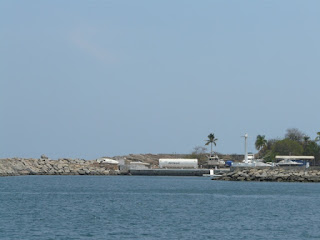 |
| Calm anchorage outside Marina Las Hades Resort |
Having checked the weather, we weighed anchor on 18th
May and motorsailed out of the bay. The wind was directly on the nose, so we tacked.
Way out at sea in deep water, when Jeremy was on watch, I saw a 2 litre water
bottle floating nearby. Unfortunately, it was attached to a long fisherman’s
line which caught around the rudder. Jeremy dived over to free it. Almost
immediately, a panga appeared from nowhere to check the line. A short while
later we nearly became tangled again on another line but this time the panga was
ahead of us and cut the line to let us through.
 |
| The handy fuel dock at Marina Las Hades, Manzanilla |
A bright orange helicopter arrived out of the sun later in
the day and circled SD, hovering close enough for me to see two persons, one of
whom waved before they flew away to the south. The wind increased from 10 knots
to 21knots and the sea became uncomfortable with stopper waves slowing us down.
Jeremy put a reef in the mainsail and we tacked, flying a small genoa as well,
motorsailing all the time.
 |
| M/V Easy aground at Punta Graham |
Day two was a repeat performance with light winds to start,
increasing to double figures by late afternoon and most of the night. Bahia de
Manzanilla with Marina Las Hadas with its fuel berth was close by. Jeremy
altered our course and we entered the bay in the dark using radar, chart
plotter, GPS, AIS and depth sounder. In this way, we avoided ships, rocks,
buoys and other hazards arriving safely at the anchorage. I went forward to
anchor and pulled only one foot of chain up. The rest was jammed solid. Not
even Jeremy could dislodge it. So at 3.00am in the dark, drifting, with the sound of surf breaking alarmingly
close by, Jeremy started emptying the front cabin to access the anchor chain
locker and untangle 50 metres of twisted chain. It took a while before the
anchor could be dropped and we could sleep at last.
 |
| One large seabird sitting on the pulpit.... |
It was a brief stop in Manzanilla but it enabled us to fill
up with diesel, give copies of our papers to the marina office, check the
engine, change the oil and filters, check the batteries, replace the ATF in the
gear box and use the laptop to check the weather. Jeremy called the Port
Captain for permission to leave and heard nothing. We left heading for Puerto
Vallarta.
 |
| ...and then there were two |
The evening was very pleasant for a change until we hit an
unidentified and unseen underwater object, which clipped the propeller. The
bilges were checked for any ingress of water but, thankfully, they were dry. Later, just as it was getting
dark, I saw ship Easy, aground on the rocks at Punta Graham. It was still
transmitting its AIS signal, but showing no lights. A shiver went down my
spine.
 |
| Our neighbours left before we could invite them for sundowners! |
The weather was settled so we decided to continue to Cabo
San Lucas, accompanied only by visiting dolphins, passing turtles and a few
seabirds. A couple of birds perched on the pulpit, taking a rest. That was fine
until sunset approached, the birds told their mates and a flock of about 20
tried to take up residence on SD. They had no fear of humans so I had to chase
them off by running forward blasting the foghorn.
 |
| More hotels at Cabo San Lucas |
We saw beautiful sunrises and sunsets. The crescent Moon
rose through the dark clouds with Venus visible nearby. Stars sparkled in the
sky above the misty shroud at sea level.
The night air felt cold and duvets and sleeping bags were brought into
service once again. Trousers and coats were needed at night.
 |
| Isla Cello la Bufadora and Isla Cello Blanco, Cabo San Lucas |
Perhaps we became a little complacent, but with only 8 knots
of SW wind when we were 64 miles from Cabo San Lucas, we thought we should
round the Cape and make landfall at Bahia Magdalena on the west of Baja
California. Jeremy put in a waypoint for Cabo Falso and we altered course. When
we were 40 miles off the wind started to blow W at 15 knots and the sea became
bumpier; by 18 miles off it was blowing 19-28 with waves breaking over us.
Jeremy tried for a little longer recording 30 knots of wind and then abandoned
the attempt and made for Cabo San Lucas. It was then that he remembered he’d
left a porthole open in the stern cabin. All his bedding was soaked.
 |
| Playa el Medano, Cabo San Lucas |
Once more we approached an anchorage in the dark, our
efforts to see ahead hampered by a large, brightly lit, private motor yacht. We dropped anchor at 0100 on 24th May. This morning we have checked in
with the Port Captain by VHF and by visiting his office ashore. We have
permission from API to stay at anchor until Monday. On the way to the Port
Captain’s Office, Jeremy took the rubbish out of his rucksack to dispose of it
and noticed that oil from the filters had leaked through two plastic bags and
through his rucksack. Fortunately, the boat’s papers were undamaged.
Unfortunately, Jeremy has spent all afternoon trying to remove oil from his
rucksack.
 |
| Lazy seal waits for fish scraps at the dinghy dock |
Hasta luego, amigos.























